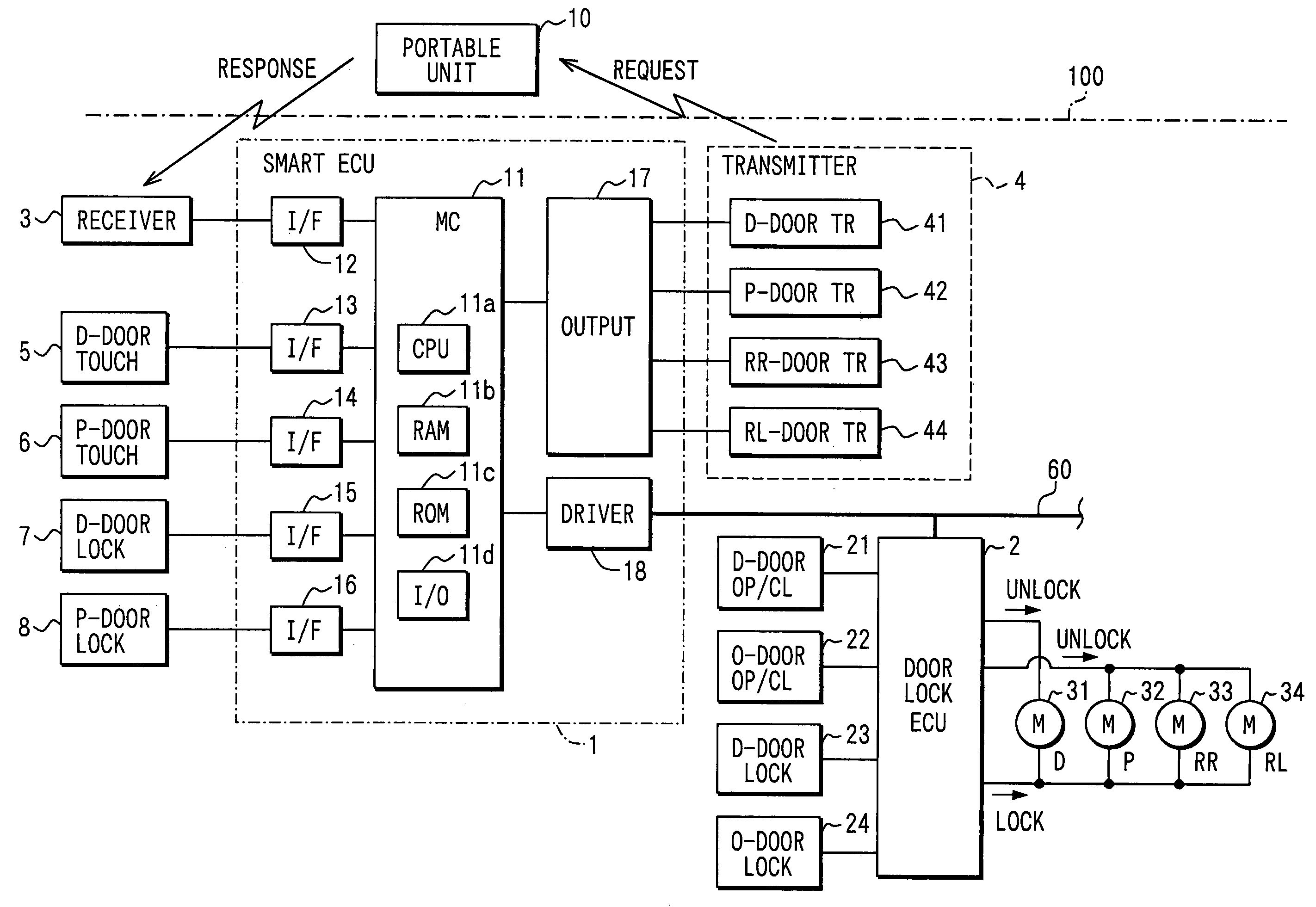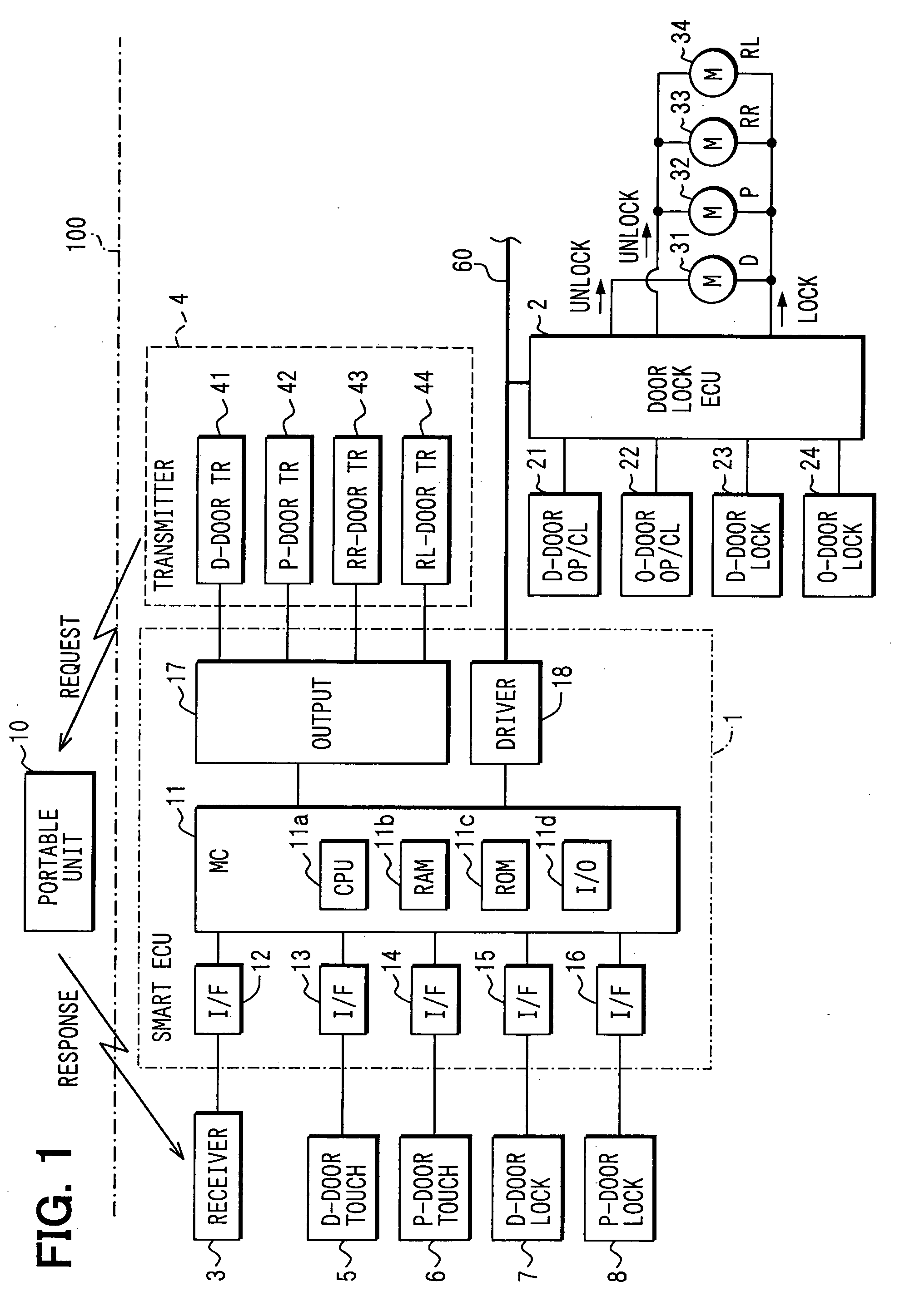Smart entry system
- Summary
- Abstract
- Description
- Claims
- Application Information
AI Technical Summary
Benefits of technology
Problems solved by technology
Method used
Image
Examples
first embodiment
[0044] Referring to FIG. 1, a smart entry system mainly includes a portable unit 10 carried by a user such as a driver or the like, a smart ECU 1, a door lock ECU 2, a receiver 3 and a transmitter 4, which are mounted on a vehicle 100. The system also includes a portable unit 10 carried by a user such as a driver or the like. The receiver 3 is mounted at Side a vehicle compartment to receive electric waves from the portable unit 10. The transmitter 4 is mounted outside the vehicle compartment for transmitting a request signal from the vehicle 100 to the portable unit 10.
[0045] The smart ECU 1 is connected to a D-door touch sensor 5 which is contained in a door handle of the door at the driver's seat (D-seat) to detect a person touch when a user touches the door handle and output a detection signal to a smart ECU 1, a P-door touch sensor 6 which is contained in a door handle of the door at the assistant driver's (passenger') seat (P-seat) to detect a person touch when the user touch...
second embodiment
[0079] The second embodiment is similar to the first embodiment. It is however different in the following points.
(1) When the D-door 51 is opened by the time when T2 elapses after the D-door 51 is first unlocked from the unlock standby state, all the doors 51 to 54 are unlocked.
[0080] (2) When the D-door 51 is not opened even when T2 elapses after the D-door 51 is first unlocked from the unlock standby state, the other three doors 52 to 54 are kept locked.
[0081]FIG. 5 shows smart door lock control processing executed by the microcomputer 11 in this embodiment in order to implement the above (1) and (2). In this smart door lock control processing, the processing of each of S110 to S170 and the processing of S230 are the same as the smart door lock control processing of the first embodiment shown in FIG. 4.
[0082] The processing of each of S171, S173, S175, S177 and S179 is carried out after the processing of S170. That is, the processing of each of S171 to S179 is carried out in ...
third embodiment
[0088] The third embodiment is also similar to the first embodiment, but different from the first embodiment in the following points. That is, when the D-door touch sensor 5 is touched under the unlock standby state, the operation state of the D-door lock switch 7 is checked. Only the D-door 51 is unlocked when the D-door lock switch 7 is operated or all the doors 51 to 54 are unlocked when the D-door lock switch 7 is not operated.
[0089] That is, when the user wants to unlock only the D-door 51, the user may touch the D-door touch sensor 5 while operating the D-door lock switch 7. On the other hand, when the user wants to unlock the doors 51 to 54, the user may merely touch the D-door touch sensor 5.
[0090]FIG. 6 shows the smart door lock control processing executed by the microcomputer 11 of this embodiment in order to implement the above operation. As shown in FIG. 6, S110 to S160 are similar to the processing in the first embodiment shown in FIG. 4. The processing of each of S16...
PUM
 Login to View More
Login to View More Abstract
Description
Claims
Application Information
 Login to View More
Login to View More - R&D
- Intellectual Property
- Life Sciences
- Materials
- Tech Scout
- Unparalleled Data Quality
- Higher Quality Content
- 60% Fewer Hallucinations
Browse by: Latest US Patents, China's latest patents, Technical Efficacy Thesaurus, Application Domain, Technology Topic, Popular Technical Reports.
© 2025 PatSnap. All rights reserved.Legal|Privacy policy|Modern Slavery Act Transparency Statement|Sitemap|About US| Contact US: help@patsnap.com



